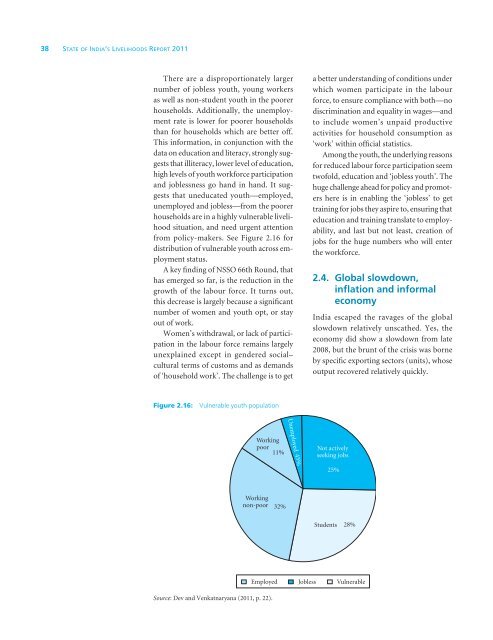SOIL Report 2011 - ACCESS Development Services
SOIL Report 2011 - ACCESS Development Services
SOIL Report 2011 - ACCESS Development Services
- No tags were found...
You also want an ePaper? Increase the reach of your titles
YUMPU automatically turns print PDFs into web optimized ePapers that Google loves.
38 State of India’s Livelihoods <strong>Report</strong> <strong>2011</strong>There are a disproportionately largernumber of jobless youth, young workersas well as non-student youth in the poorerhouseholds. Additionally, the unemploymentrate is lower for poorer householdsthan for households which are better off.This information, in conjunction with thedata on education and literacy, strongly suggeststhat illiteracy, lower level of education,high levels of youth workforce participationand joblessness go hand in hand. It suggeststhat uneducated youth—employed,unemployed and jobless—from the poorerhouseholds are in a highly vulnerable livelihoodsituation, and need urgent attentionfrom policy-makers. See Figure 2.16 fordistribution of vulnerable youth across employmentstatus.A key finding of NSSO 66th Round, thathas emerged so far, is the reduction in thegrowth of the labour force. It turns out,this decrease is largely because a significantnumber of women and youth opt, or stayout of work.Women’s withdrawal, or lack of participationin the labour force remains largelyunexplained except in gendered social–cultural terms of customs and as demandsof ‘household work’. The challenge is to geta better understanding of conditions underwhich women participate in the labourforce, to ensure compliance with both—nodiscrimination and equality in wages—andto include women’s unpaid productiveactivities for household consumption as‘work’ within official statistics.Among the youth, the underlying reasonsfor reduced labour force participation seemtwofold, education and ‘jobless youth’. Thehuge challenge ahead for policy and promotershere is in enabling the ‘jobless’ to gettraining for jobs they aspire to, ensuring thateducation and training translate to employability,and last but not least, creation ofjobs for the huge numbers who will enterthe workforce.2.4. Global slowdown,inflation and informaleconomyIndia escaped the ravages of the globalslowdown relatively unscathed. Yes, theeconomy did show a slowdown from late2008, but the brunt of the crisis was borneby specific exporting sectors (units), whoseoutput recovered relatively quickly.Figure 2.16: Vulnerable youth populationSource: Dev and Venkatnaryana (<strong>2011</strong>, p. 22).














